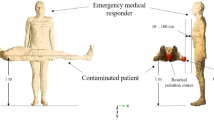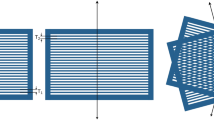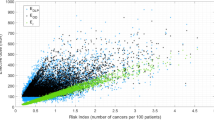Abstract
Background
Modeling of dose distribution of randomly moving population around a radioactive source is a complex problem.
Objective
The objective is to develop a model and solution techniques to estimate radiation absorbed dose to the population randomly moving around a radioactive source.
Methods
The problem is formulated using a second-order partial differential equation; different moments of the dose distribution function are defined related to physically realizable quantities, and solutions are obtained using standard moments methods. Alternatively, numerical simulations are performed to estimate the radiation doses using Monte Carlo approach for individual positions and random motions of the people around the source.
Results
A good agreement is found between average doses obtained from moments method and numerical simulations. A typical application of this model to different exposure conditions shows that the average dose is highly dependent on the population density. The study results show that average dose decreases with increase in the population density and movement area of random walker.
Significance
This mathematical model can be used as a rapid assessment tool by the emergency planners in resource optimization by providing quick estimates of likely exposures for triage and emergency response.
This is a preview of subscription content, access via your institution
Access options
Subscribe to this journal
Receive 6 print issues and online access
$259.00 per year
only $43.17 per issue
Buy this article
- Purchase on SpringerLink
- Instant access to full article PDF
Prices may be subject to local taxes which are calculated during checkout





Similar content being viewed by others
References
Tofani A, Bartolozzi M. Ranking nuclear and radiological terrorism scenarios: the Italian case. Risk Anal. 2008;28:1431–43.
Tofani A. Assessing the radiological impact of radiation exposure devices. Risk Anal. 2010;31:566–77.
Hinton TG, Byrne ME, Webster SC, Love CN, Broggio D, Trompier F, et al. GPS-coupled contaminant monitors on free-ranging Chernobyl wolves challenge a fundamental assumption in exposure assessments. Environ Int. 2019;133:105152.
Pederson SL, Li Puma MC, Hayes JM, Okuda K, Reilly CM, Beasley JC, et al. Effects of chronic low-dose radiation on cataract prevalence and characterization in wild boar (Sus scrofa) from Fukushima, Japan. Sci Rep. 2020;10:4055.
Sobol IM. A primer for the Monte Carlo method. 1st ed. Boca Raton: CRC Press; 1994.
Kalos MH, Whitlock PA. Monte Carlo methods. 2nd ed. Weinheim: Wiley-VCH Verlag GmbH & Co. KGaA; 2008. ISBN: 978-3-527-40760-6.
Khider M, Kaiser S, Patrick R, Michael A. A novel movement model for pedestrians suitable for personal navigation. Proceedings of the 2008 National Technical Meeting of The Institute of Navigation, San Diego, CA; 2008. p. 819–27.
Codling EA, Plank MJ, Simon B. Random walk models in biology. J R Soc Interface. 2008;5:813–34.
Seyfried A, Steffen B, Klingsch W, Boltes M. The fundamental diagram of pedestrian movement revisited. J Stat Mech: Theory Exp. 2005;10:P10002.
Mathematica Version 5.2. Champaign, IL: Wolfram Research, Inc.; 2005.
Timmermans HJP. Pedestrian behavior: models, data collection and applications. Bingley, UK: Emerald; 2009.
Author information
Authors and Affiliations
Corresponding author
Ethics declarations
Competing interests
The authors declare no competing interests.
Additional information
Publisher’s note Springer Nature remains neutral with regard to jurisdictional claims in published maps and institutional affiliations.
Supplementary information
Rights and permissions
About this article
Cite this article
Kumar, P., Anand, S., Singh, K.D. et al. Dose distribution to a random walker moving in a two-dimensional surface around a radioactive source. J Expo Sci Environ Epidemiol 32, 188–194 (2022). https://doi.org/10.1038/s41370-021-00367-9
Received:
Revised:
Accepted:
Published:
Issue date:
DOI: https://doi.org/10.1038/s41370-021-00367-9



